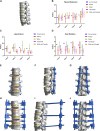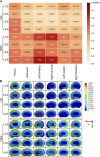Biomechanical analysis of the tandem spinal external fixation in a multiple-level noncontiguous lumbar fractures model: a finite element analysis
- PMID: 38962665
- PMCID: PMC11219947
- DOI: 10.3389/fbioe.2024.1395197
Biomechanical analysis of the tandem spinal external fixation in a multiple-level noncontiguous lumbar fractures model: a finite element analysis
Abstract
Objective: This study aimed to investigate the biomechanical characteristics of the tandem spinal external fixation (TSEF) for treating multilevel noncontiguous spinal fracture (MNSF) using finite element analysis and provide a theoretical basis for clinical application.
Methods: We constructed two models of L2 and L4 vertebral fractures that were fixed with the TSEF and the long-segment spinal inner fixation (LSIF). The range of motion (ROM), maximum stresses at L2 and L4 vertebrae, the screws and rods, and the intervertebral discs of the two models were recorded under load control. Subsequently, the required torque, the maximum stress at L2 and L4 vertebrae, the screws and rods, and the intervertebral discs were analyzed under displacement control.
Results: Under load control, the TSEF model reserved more ROM than the LSIF model. The maximum stresses of screws in the TSEF model were increased, while the maximum stresses of rods were reduced compared to the LSIF model. Moreover, the maximum stresses of L2 and L4 vertebrae and discs in the TSEF model were increased compared to the LSIF model. Under displacement control, the TSEF model required fewer moments (N·mm) than the LSIF model. Compared to the LSIF model, the maximum stresses of screws and rods in the TSEF model have decreased; the maximum stresses at L2 and L4 in the TSEF model were increased. In the flexion condition, the maximum stresses of discs in the TSEF model were less than the LSIF model, while the maximum stresses of discs in the TSEF model were higher in the extension condition.
Conclusion: Compared to LSIF, the TSEF has a better stress distribution with higher overall mobility. Theoretically, it reduces the stress concentration of the connecting rods and the stress shielding of the fractured vertebral bodies.
Keywords: biomechanics; finite element analysis; multilevel noncontiguous spinal fracture; tandem spinal external fixation; thoracolumbar fracture.
Copyright © 2024 Chen, Kang, Yan, Wang, Peng, Liao, Zou, Xu, Song, Wang and Wang.
Conflict of interest statement
The authors declare that the research was conducted in the absence of any commercial or financial relationships that could be construed as a potential conflict of interest.
Figures







Similar articles
-
Advances in the clinical diagnosis and treatment of multiple-level noncontiguous spinal fractures.Front Neurol. 2024 Nov 21;15:1469425. doi: 10.3389/fneur.2024.1469425. eCollection 2024. Front Neurol. 2024. PMID: 39639988 Free PMC article. Review.
-
Extent and location of fixation affects the biomechanical stability of short- or long-segment pedicle screw technique with screwing of fractured vertebra for the treatment of thoracolumbar burst fractures: An observational study using finite element analysis.Medicine (Baltimore). 2018 Jun;97(26):e11244. doi: 10.1097/MD.0000000000011244. Medicine (Baltimore). 2018. PMID: 29952989 Free PMC article.
-
Biomechanical Comparison of Different Treatment Strategies for Thoracolumbar Burst Fracture: A Finite Element Study.World Neurosurg. 2023 Dec;180:e429-e439. doi: 10.1016/j.wneu.2023.09.084. Epub 2023 Sep 25. World Neurosurg. 2023. PMID: 37757943
-
Treatment of thoracolumbar burst fractures by short-segment pedicle screw fixation using a combination of two additional pedicle screws and vertebroplasty at the level of the fracture: a finite element analysis.BMC Musculoskelet Disord. 2017 Jun 15;18(1):262. doi: 10.1186/s12891-017-1623-0. BMC Musculoskelet Disord. 2017. PMID: 28619021 Free PMC article.
-
Biomechanical comparison of multilevel lateral interbody fusion with and without supplementary instrumentation: a three-dimensional finite element study.BMC Musculoskelet Disord. 2017 Feb 2;18(1):63. doi: 10.1186/s12891-017-1387-6. BMC Musculoskelet Disord. 2017. PMID: 28153036 Free PMC article.
Cited by
-
Advances in the clinical diagnosis and treatment of multiple-level noncontiguous spinal fractures.Front Neurol. 2024 Nov 21;15:1469425. doi: 10.3389/fneur.2024.1469425. eCollection 2024. Front Neurol. 2024. PMID: 39639988 Free PMC article. Review.
References
LinkOut - more resources
Full Text Sources

